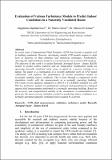Evaluation of various turbulence models to predict indoor conditions in a naturally ventilated room
Date
2013Author
Hajdukiewicz, Magdalena
Geron, M.
Keane, MM
Metadata
Show full item recordUsage
This item's downloads: 475 (view details)
Recommended Citation
Hajdukiewicz, M; Geron, M.; Keane, MM (2013) Evaluation of various turbulence models to predict indoor conditions in a naturally ventilated room The 11th REHVA World Congress & 8th International Conference on IAQVEC (CLIMA 2013) Prague, Czech Republic, 2013-06-16- 2013-06-19
Abstract
In recent years, Computational Fluid Dynamics (CFD) has
become a popular tool in building simulation. However, developing reliable CFD
models requires a high level of expertise in fluid dynamics and numerical
techniques. Furthermore, choosing the right turbulence model is a crucial issue
for an accurate CFD analysis. The objective of this work is to utilise Reynolds Averaged
Navier - Stokes (RANS) models to predict airflow patterns and air temperature
stratification inside an operating naturally ventilated study room, occupied by
a person working on a laptop. The paper is a continuation of a recently
published work on CFD model calibration; and explores the performance of
various turbulence models to accurately simulate indoor conditions. This is
done through a comparison of the simulation results with the measurements in a normally
operating building. The results of zero equation, standard k-ε, RNG k-ε, k-ε EARSM, standard k-ω
and SST k-ω turbulence models are qualitatively analysed and quantitatively evaluated
against field measurements performed in a normally operating building. Based on
the accuracy and computational stability of the simulations, recommendations
are given for the most accurate turbulence model in predicting indoor
conditions in a normally operating naturally ventilated room occupied by a
person.
Description
Conference paper


